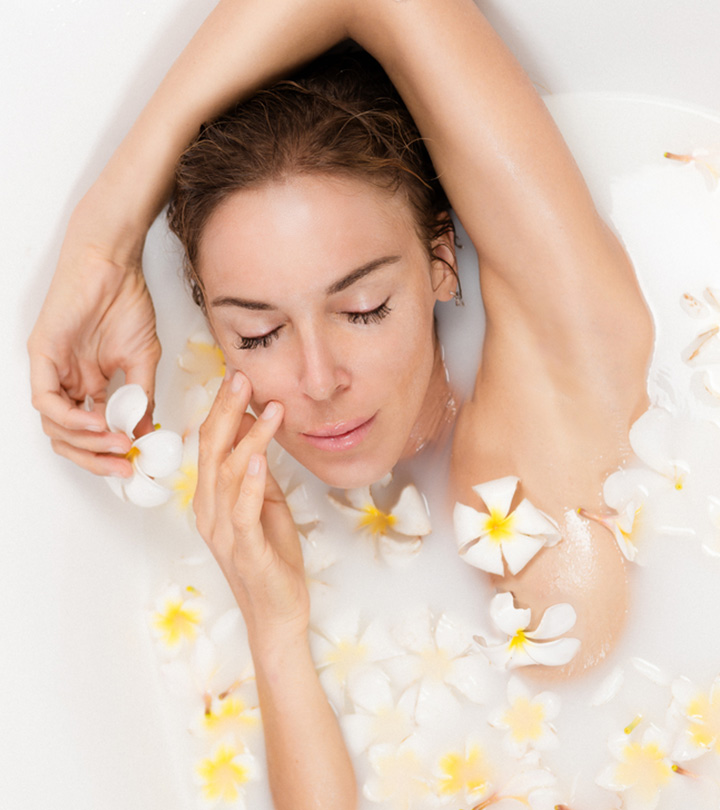We all want our skin to be smooth, silky, and luminous. Did you know that the most soothing and hydrating way to achieve this is to soak in a milk bath? Yes, its dual exfoliation and moisturization action leaves your skin feeling supple, smooth, radiant, and flawless. Read on to learn all about milk bath recipes without wasting any ingredients. Keep scrolling!
In This Article
What Is A Milk Bath?
A milk bath is a bath made with milk as the main ingredient. Milk’s skin-nourishing properties help soften rough and dry skin and keep it glowing and supple. One can also add flower petals, essential oils, and bath salts to make the milk bath relaxing and rejuvenating. You can use cow milk or even other kinds of milk to make your own milk bath. In the next section, we have listed the other types of milk you can use in your milk bath. Keep reading.
Fun FactPliny The Elder, author and army commander of the early Roman empire, was the first to document milk bath in his encyclopedia ‘Natural History.’
Which Milk To Use?
Shutterstock
Here’s a list of milk from various sources you can use to prepare your milk bath:
Donkey Milk: Legend has it that the Egyptian pharaoh, the enigmatic Cleopatra, bathed in donkey milk. The 21st-century scientists have also found a positive effect of applying donkey milk to the skin. Applying creams formulated with donkey milk improved skin hydration and sealed skin moisture, keeping it softer for longer (1). Donkey milk also has anti-inflammatory, wound healing, and skin regenerative properties that help soothe the skin and make it radiant (2).
Cow Milk: Cow milk is easily available and has nourishing properties that are good for the skin. Scientists had found wound-healing properties in low-fat cow milk (3). But you can also use full-fat milk if you have very dry skin.
Coconut Milk: Coconut milk is obtained from pressing grated coconut flesh. While coconut oil is known for its moisturizing properties, coconut milk is equally effective for the skin. The phenolic compounds in coconut milk may protect skin against oxidative damage and help slow down skin aging (4).
Buttermilk: Buttermilk is fermented milk loaded with lactic acid (5). Lactic acid is an alpha hydroxy acid (AHA) popular for exfoliating the skin (6).
Almond Milk: Almond milk is obtained from pressed whole almonds. Almond skin is rich in flavonoids that have antimicrobial properties (7). The milk could also be a good alternative to those allergic to cow milk.
Goat Milk: Goat milk and cow milk are similar in composition. Goat milk, too, helps nourish and hydrate the skin. However, if you are allergic to cow milk, you may want to avoid goat milk as well (8).
Oat Milk: Oat milk is made of colloidal oats used in many skin creams and lotions. It has antioxidant and anti-inflammatory properties (8). It is perfect for dry, sensitive, or acne-prone skin.
StyleCraze SaysYou can also use rice and soy milk for milk baths. Also, the full-fat versions of animal milk are pretty nourishing.
These are the various milk sources you can use for your DIY milk bath. Let us now take a look at the different milk bath recipes that you can prepare in under 5 minutes.
5 Best DIY Milk Bath Recipes And How To Use
1. Milk And Honey Bath
Shutterstock
- Take 2 cups of milk of your choice.
- Mix 4 tablespoons of organic honey with it.
- Add the mixture to the lukewarm water bath.
- Soak in it for 30 minutes.
- Do this twice a week if you have dry skin.
Related: Is Honey Good For The Face And Skin? How To Use It?
2. Oatmeal Bath
- Take a cup of oatmeal and grind it to a fine powder.
- Add ½ a cup of warm water and wait for 15 minutes.
- Stir well and pour the oatmeal colloidal into your lukewarm water bath.
- Add a generous squeeze of olive oil and 2 drops of lemon essential oil.
- Soak in it for 30 minutes.
- Do this two to three times a week if you have calluses and rough skin.
Related: 22 Best Benefits Of Oatmeal For Skin, Hair, And Health
3. Lavender Milk Bath
Shutterstock
- Take 2 cups of buttermilk.
- Mix it with ½ a cup of almond milk (or low-fat cow milk).
- Add 1 teaspoon of baking soda. Mix well.
- Pour it into a lukewarm water bath.
- Add 4 drops of lavender essential oil and dried lavender.
- Soak in it for 30 to 40 minutes.
- Do this once a week to exfoliate skin/remove dead skin layers.
4. Coconut Milk And Rose Bath
- Take 1 cup of coconut milk and pour it into the lukewarm water bath.
- Add 7 drops of coconut oil and 4 drops of rose essential oil.
- Scatter some rose petals and soak them for 30 minutes.
- Do this twice or thrice a week for soft and glowing skin.
5. Goat Milk Bath With Epsom Salt
Shutterstock
- Take 2 cups of goat milk and mix with ½ a cup of buttermilk.
- Add it to the lukewarm water bath.
- Add ¾ cup of Epson salt and 5 drops of neem essential oil.
- Soak in it for 30 minutes.
- Do it once a week to even out your skin tone, reduce dark spots, and rejuvenate your skin.
Note: You can use milk powder as well. However, milk powder contains additives that may not be ideal for your skin. Also, all of the milk bath recipes mentioned above can be used with any milk of your choice.
Now that you know how to prepare a milk bath at home, let’s take a quick look at the benefits of a milk bath for skin in the section below. These benefits are based on anecdotal evidence. More research is warranted in this regard.
Related: 7 Benefits Of Epsom Salt, How It Works, And Side Effects
Milk Bath Benefits For Skin
- Moisturizes the skin.
- Exfoliates the skin
- Relieves sunburn.
- Protects the skin from oxidative damage.
- Reduces fine lines and wrinkles.
- Smoothens skin texture.
- Rejuvenates the skin.
- Helps relax and reduces stress.
- Improves sleep quality.
Clearly, a relaxing DIY milk bath is easy, quick, and effective on your skin. But does it have any risks or side effects? Read on to find out.
Are There Any Risks?
Shutterstock
If you are allergic to any of the milk variants or ingredients mentioned above, avoid use. Rashes, swelling, and itching are signs that you are allergic to any of the ingredients used in the milk bath. Always do a patch test before using the ingredients. Apply a small amount of milk (and other ingredients) at the back of your hand or neck. Wait for 2 hours to see if you develop any allergic reactions.
Note: Avoid milk bath if you have oily or acne-prone skin, high fever, or nausea.
Next time you plan to take a long, relaxing, and hot soak, try the milk bath recipes discussed in the article. You will love it if you have dry and rough skin, as milk baths can make the skin soft, smooth, and glowing. Moreover, you can add herbs and fragrant oils to make it more luxurious and get a spa-like feeling at home. Milk baths feel extremely rejuvenating and relaxing. However, note that they may not heal any skin condition. You can take milk baths once a week to keep your skin feeling soft and good and relax your mind.




